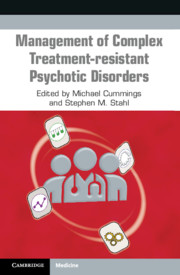Book contents
- Management of Complex Treatment-Resistant Psychotic Disorders
- Management of Complex Treatment-Resistant Psychotic Disorders
- Copyright page
- Contents
- Contributors
- Acknowledgements
- Abbreviations
- List of Icons
- Introduction
- Part I Treatment Strategies
- 1.01 Approaches to Positive Psychotic Symptoms
- 1.02 Use of Plasma Levels in Antipsychotic and Mood Stabilizer Treatment
- 1.03 Advantages of Long-Acting Injectable Antipsychotics
- 1.04 Approach to Treatment-Resistant Schizophrenia Spectrum Patients
- 1.05 Approach to Depressed or Suicidal Schizophrenia Spectrum Patients
- 1.06 Approach to Persistent Aggression and Violence in Schizophrenia Spectrum Psychotic Disorders
- 1.07 Approach to Bipolar Diathesis in Schizophrenia Spectrum Patients
- 1.08 Approach to Anxiety in Schizophrenia Spectrum Patients
- 1.09 Approach to Insomnia and Sleep Disturbance in Schizophrenia Spectrum Disorders
- 1.10 Approach to Psychosis in Children and Adolescents
- 1.11 Electroconvulsive Therapy and Other Non-Pharmacological Treatments
- 1.12 Approach to Substance Use Disorders in Schizophrenia Spectrum Disorders
- 1.13 Approaches to Behavioral Disturbances in Dementia and Traumatic Brain Injury Patients
- Part II Medication Reference Tables
- Appendices
- Index
- References
1.13 - Approaches to Behavioral Disturbances in Dementia and Traumatic Brain Injury Patients
from Part I - Treatment Strategies
Published online by Cambridge University Press: 19 October 2021
- Management of Complex Treatment-Resistant Psychotic Disorders
- Management of Complex Treatment-Resistant Psychotic Disorders
- Copyright page
- Contents
- Contributors
- Acknowledgements
- Abbreviations
- List of Icons
- Introduction
- Part I Treatment Strategies
- 1.01 Approaches to Positive Psychotic Symptoms
- 1.02 Use of Plasma Levels in Antipsychotic and Mood Stabilizer Treatment
- 1.03 Advantages of Long-Acting Injectable Antipsychotics
- 1.04 Approach to Treatment-Resistant Schizophrenia Spectrum Patients
- 1.05 Approach to Depressed or Suicidal Schizophrenia Spectrum Patients
- 1.06 Approach to Persistent Aggression and Violence in Schizophrenia Spectrum Psychotic Disorders
- 1.07 Approach to Bipolar Diathesis in Schizophrenia Spectrum Patients
- 1.08 Approach to Anxiety in Schizophrenia Spectrum Patients
- 1.09 Approach to Insomnia and Sleep Disturbance in Schizophrenia Spectrum Disorders
- 1.10 Approach to Psychosis in Children and Adolescents
- 1.11 Electroconvulsive Therapy and Other Non-Pharmacological Treatments
- 1.12 Approach to Substance Use Disorders in Schizophrenia Spectrum Disorders
- 1.13 Approaches to Behavioral Disturbances in Dementia and Traumatic Brain Injury Patients
- Part II Medication Reference Tables
- Appendices
- Index
- References
Summary
Of the many behavioral disturbances associated with severe mental and neurocognitive disorders, impulsive behaviors, including agitation and aggression, present unique challenges. Frontal inhibition, cognitive impairments, and executive dysfunction commonly combine to promote behavioral disturbances in severe mental and neurocognitive disorders, and the interplay between structures and circuits may explain a mechanism for the impulsive behaviors, agitation, and aggression. A circuit of periaqueductal gray matter, hippocampus, amygdala, and hypothalamus mediates threat response, a bottom-up impulse. Prefrontal cortex (PFC) serves a top-down role to inhibit those bottom-up impulses, and PFC dysfunction impairs a person’s ability to recognize social cues and increases the risk of impulsive aggressive responses by a person failing to make appropriate risk/reward assessments for inhibiting responses. Added sensory deficits in hearing, vision, or pain together with sensory processing and appraisal deficits in cognition combine to foster behavioral disturbances of agitation, aggression, and impulsive acts [1]. Of the PFC, specifically the ventromedial PFC and its connections to lower structures, such as the amygdala, serve this top-down inhibitory function [1, 2]. PFC-amygdala circuit connectivity is disrupted by dysfunction in associated serotonin and dopamine systems in several mental conditions. Enhancing serotonergic and dopaminergic signaling in and around this circuit provides a theoretical approach to pharmacologic agent selection for many of these behavioral disturbances. Severe mental and neurocognitive disorders, including traumatic brain injury (TBI), often show pathology in the brain regions associated with top-down and bottom-up structures, as described above [3].
- Type
- Chapter
- Information
- Publisher: Cambridge University PressPrint publication year: 2021



